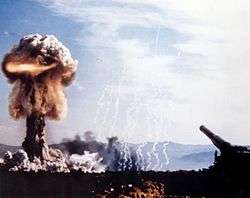W9 (nuclear warhead)

The W9 was an American nuclear artillery shell fired from a special 11 inch howitzer. It was produced starting in 1952 and all were retired by 1957.
Description
The W9 was 11 inches (280 mm) in diameter, 55 inches (138 cm) long, and weighed 850 pounds (364 kg). It had an explosive yield of 15 kilotons.
The W9 was a gun-type nuclear weapon, using around 50 kilograms of highly enriched uranium in one large rings assembly and one smaller "bullet", which was fired down a tube by conventional explosives into the rings assembly to achieve critical mass and detonate the weapon.
The W9 units which were retired in 1957 were recycled into lower yield T-4 Atomic Demolition Munitions. These were the first (semi) man-portable nuclear weapons.
Tests
The W9 is only the second gun-type nuclear weapon known to have been detonated; the first was the Little Boy nuclear weapon used in World War II.
The W9 artillery shell was test fired once, fired from the "Atomic Annie" M65 Atomic Cannon, in Upshot-Knothole Grable on May 25, 1953 at the NTS. Yield was the expected 15 kilotons.
Subsequently, the W33 nuclear artillery shell was test fired twice (not in a gun) during its development (shots Nougat/Aardvark and Plumbbob/Laplace). These four detonations are the only identified gun-type bomb detonations.